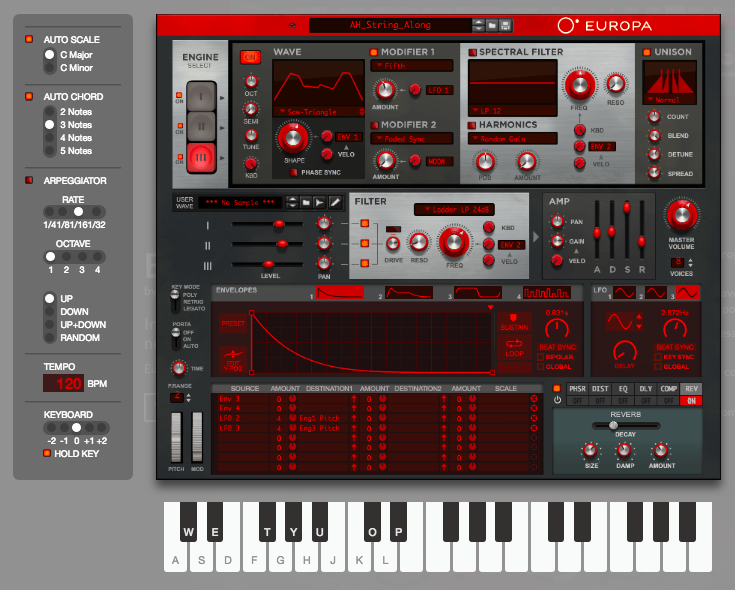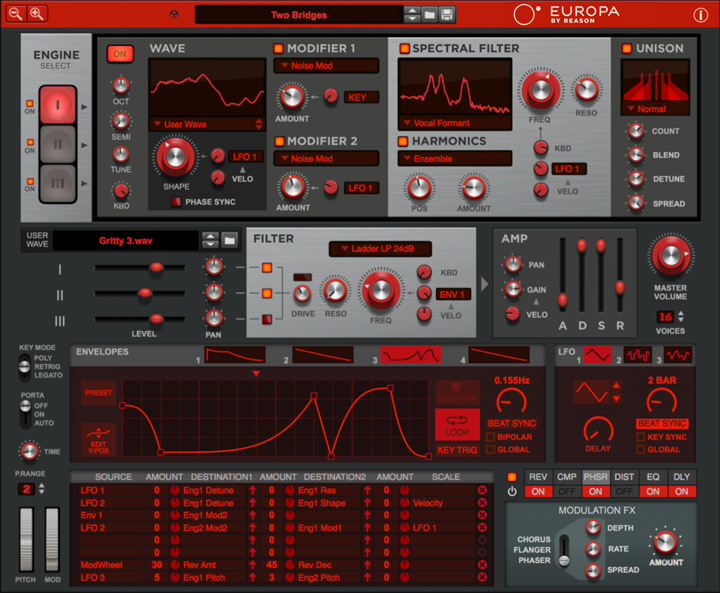New Software Review: Europa Synth from Reason
Propellerhead‘s Reason has long been one of the most beloved DAWs among producers, thanks to its ease of use and huge collection of built-in sounds, effects, and potential for deep customization.
Up until recently, Reason has had a strict closed-door policy to the world of third party plugins, leaving its user-base at the mercy of Propellerhead for the addition of any new devices into the DAW. But that’s all in the past, and Reason is now compatible with third party synthesizers like Serum, Massive, and Sylenth.
Now, Reason has offered up its own Europa synth—a plugin that is designed to be highly competitive with other third party offerings. Also available as an AU/VST for users of other DAWs, Europa extends Propellerhead’s reach beyond the world of Reason for the first time ever. Today, we are going to explore Europa and see if it stands out in a very saturated market of wavetable synthesizers.
Features
Europa, like the above-mentioned third party synths, is also of the wavetable variety—but what differentiates it from the others? Before experimenting for myself, I watched Andrew Huang’s video review of Europa, entitled “It Turns Any Sound INTO A WAY COOLER SOUND”, and became quite excited to explore this new instrument.
In terms of features, Europa offers 4 envelopes and 3 LFOs to pick as modulation sources, and 3 distinct sound engines—each with their own filter, modifiers, and unison controls. There is a section at the upper left of the GUI where you can select between engines 1-3, and you can create your own wavetables by using envelopes 3 and 4 and selecting “Envelope 3-4” in the engine. The Shape rotary will now morph between the envelope shapes in slots 3 and 4. You can also create your own custom filter curve in the Spectral Filter by choosing “Envelope 4” and drawing your own curve.
Also available in Europa is an Amp section with ADSR controls, and a Master Effects section offering EQ, compression, distortion, and a wealth of time-based and other special effects.
One of the biggest standout features of Europa is that you can import your own samples and use them as sources, create your own custom wavetables with them, or even use them as a filter. The latter works by generating a filter from an FFT analysis of the external sample you have loaded in the User Wave section—something I’ve yet to see another plugin wavetable synth offer!
In Use
In terms of workflow, Europa is amazingly intuitive; I love that almost every knob is easily visible for quick adjustments.
There is an online web player version of Europa with a Help section on the right—so when you hover your mouse over different sections of the synth, you can learn more about what each knob does. You can also make presets right in the web browser, which you can later export and use directly in the plugin version.

The web browser version of Europa loads within seconds and gives a clear idea of the synth’s features and capabilities.
I didn’t have to consult the manual much when trying to learn what Europa was capable of, but when I did, I found some very helpful tips and tricks. For example, to create a classic vocoder effect, the manual states:
“Load a vocal/speech sample in the User Wave section. Then, set the Freq knob to 50%, the Reso knob to 0% and the KBD knob to 0%. Then, have one of the Envelopes modulate the Reso parameter using the Modulation Bus (see “The Modulation Bus section”). Create a positive ramp (inverted sawtooth) envelope and set the Reso modulation amount to 100%.”
Using the guidance from the manual, I was able to produce very musical and inspiring sounds—and as a side note, I even decided to make a song only using Europa with no additional audio effects or other synths. I’m happy to report it was a success!
The shaping section in Europa allows you to add dirt and saturation to your sounds, and it’s also visually stimulating to see how it affects the waveforms. I also found the Unison options to be really helpful for adding thickness and width, and the ability to add an octave, fourth, or fifth is also very cool.
To Be Critical
While I love that Europa is easy to navigate despite its complex features, it isn’t the perfect synth for everything. While the filters and oscillators have a distinct character, there is an inherently digital quality to them, and I found it hard to emulate a round Moog-like bass sound.
Additionally, you can only load one user wave at a time, which means if you want to upload your own sample to use as a filter, you can’t simultaneously use a different custom noise as a sound source in the sound engines.
I also found that navigating the presets was a bit complex, as the drop-down menu doesn’t allow subfolders. So if I want to go to a bass preset, I have to go to the Patch Selector (the little folder icon at the top right) and then select the preset folder “Bass” in order to get to my bass presets. If I then want to go to my lead sounds, I have to repeat the process and select my “Leads” folder. Propellerhead may want to consider making an update that allows for submenus in their preset browser—I think most users would be thankful.
Summing it Up
Because there is so much competition in the world of plugin synthesizers (especially wavetable synths), creating a tool that stands out can be very difficult. With Europa, Propellerhead has delivered not just an inspiring and musical tool, but one that extends their reach to users far beyond the Reason platform.
Europa costs $149, which is the same price as Native Instruments’ Massive, and a little cheaper than Xfer Records Serum ($189) and Lennar Digital Sylenth1 (€130). One important thing to consider though, is that you get the VST version of Europa for free if you already own Reason 10.
Making Europa available as a VST seems like a really good move to get more people into Reason, and I hope Propellerhead makes Thor available as a separate VST too! The addition of the web browser version is also a great way of recruiting new users, and something all plugin developers should consider doing.
To be honest, I got Sylenth1 thinking it would be my go-to synth for everything until I found out how simple Serum was to program. I then started using Sylenth for super saws and acid bass parts until a producer friend showed me a trick for making fat 808’s in Massive—and from there, things got a bit out of hand.
Having said this, Europa definitely holds its own as a phenomenal synth for creating inspiring sounds very quickly, thanks to its visually-appealing interface and general ease of use. I wouldn’t be surprised if Europa becomes one of my go-to plugins for creating evolving pads, ominous drones, and leads that will make peoples’ ears bleed.
Please note: When you buy products through links on this page, we may earn an affiliate commission.







